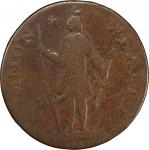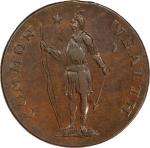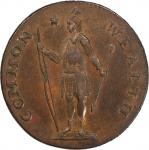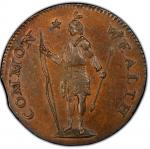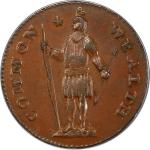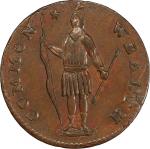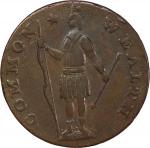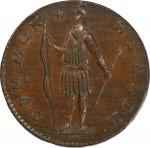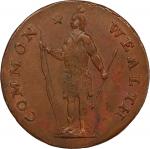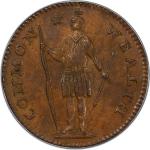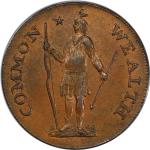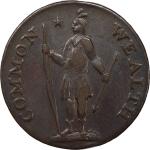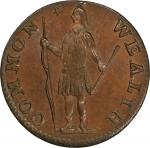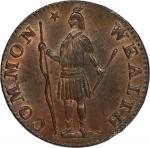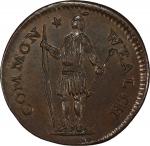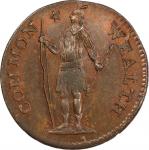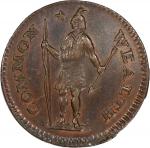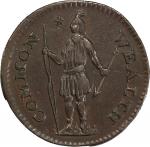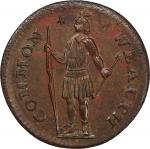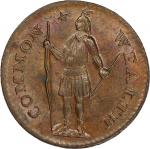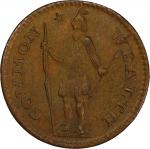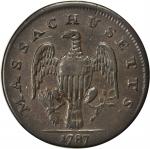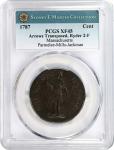1787 Massachusetts Cent. Ryder 2-F, W-6070. Rarity-6. Transposed Arrows. EF-45 (PCGS). 155.7 grains. A truly special coin and one of the preeminent highlights of Martins fine collection of Massachusetts coppers. We are pleased to once again be offering this exceptional piece just three years after its appearance in our Spring 2019 Baltimore auction as part of the Twin Leaf Collection, where it was acquired by Syd Martin. As described in that catalog, the surfaces are a glossy deep olive-brown, uniform and lovely. A couple of tiny nicks are noted on the obverse but will only be seen under close examination. On the reverse a short scratch underlines the second A of MASSACHUSETTS, while a natural thin planchet flaw passes from the rim over U through the shield, left of the T of CENT, and to the left corner of the fifth shield stripe. Beautifully centered, well struck, and simply a very attractive coin.<br data-uw-rm-sr="" data-uw-styling-context="true" role="presentation" style="box-sizing:border-box;font-variant-ligatures:normal;font-variant-caps:normal;orphans:2;text-align:start;widows:2;-webkit-text-stroke-width:0px;text-decoration-thickness:initial;text-decoration-style:initial;text-decoration-color:initial;word-spacing:0px;" /><br data-uw-rm-sr="" data-uw-styling-context="true" role="presentation" style="box-sizing:border-box;font-variant-ligatures:normal;font-variant-caps:normal;orphans:2;text-align:start;widows:2;-webkit-text-stroke-width:0px;text-decoration-thickness:initial;text-decoration-style:initial;text-decoration-color:initial;word-spacing:0px;" />The Transposed Arrows cent stands out among Massachusetts coppers not just for its obvious engravers error, but also in terms of its general styling. Two contracts were entered into by the Commonwealth for the coinage of Massachusetts and the issued coins exhibit two distinct styles overall, mostly in the shape of the S punches. The first contract was with Joseph Callender of Boston, who prepared the earliest and largest number of dies. It is believed that his dies can be distinguished by the more open S style. The second contract was with Joseph Perkins of Newburyport, and it is believed that the heavier, more closed S styles that can be seen on the half cents of 1788 and some of the 1788 cents are attributable to him. This distinction places the Transposed Arrows in the first group, but there is more. This reverse die is the only one with the letters of CENT rendered in relief in the shield, and it is also the only 1787 cent die with a very compact and refined styling to the date. Finally, the eagles tail feathers are uniquely styled as well, in that they only mildly flare outward. These unique features have led to the conclusion that the rare Transposed Arrows reverse was likely the very first reverse die of the entire series, with the discovery of the error having perhaps something to do with the rarity of the issue today.<br data-uw-rm-sr="" data-uw-styling-context="true" role="presentation" style="box-sizing:border-box;font-variant-ligatures:normal;font-variant-caps:normal;orphans:2;text-align:start;widows:2;-webkit-text-stroke-width:0px;text-decoration-thickness:initial;text-decoration-style:initial;text-decoration-color:initial;word-spacing:0px;" /><br data-uw-rm-sr="" data-uw-styling-context="true" role="presentation" style="box-sizing:border-box;font-variant-ligatures:normal;font-variant-caps:normal;orphans:2;text-align:start;widows:2;-webkit-text-stroke-width:0px;text-decoration-thickness:initial;text-decoration-style:initial;text-decoration-color:initial;word-spacing:0px;" />Legendary collector Joseph Mickley owned an example of the Transposed Arrows cent, called "Very Fine" in the 1867 sale of his collection (lot 2390). It sold to Edward Cogan for $40, a handsome sum. The description included this commentary: "…of this type only one other is known, and that was formerly in the collection of Seth E. Pecker, Esq., of Boston, and was stolen, with the rest of his collection, a year or two ago. So far as collections are concerned, the coin is now unique. Unlike the other known specimen, this is in very fine condition." This passage states two things of importance. First, that there were only two known in 1867, one of which was lost, and second, that the lost piece was of apparently inferior quality.<br data-uw-rm-sr="" data-uw-styling-context="true" role="presentation" style="box-sizing:border-box;font-variant-ligatures:normal;font-variant-caps:normal;orphans:2;text-align:start;widows:2;-webkit-text-stroke-width:0px;text-decoration-thickness:initial;text-decoration-style:initial;text-decoration-color:initial;word-spacing:0px;" /><br data-uw-rm-sr="" data-uw-styling-context="true" role="presentation" style="box-sizing:border-box;font-variant-ligatures:normal;font-variant-caps:normal;orphans:2;text-align:start;widows:2;-webkit-text-stroke-width:0px;text-decoration-thickness:initial;text-decoration-style:initial;text-decoration-color:initial;word-spacing:0px;" />What we have been able to prove of the story of this specimen begins with Sylvester S. Crosby who published in his famous 1875 reference, <em>The Early Coins of America</em>, descriptions of the various dies of Massachusetts coppers. With regard to 2-F, he commented that the reverse "deserves particular notice," after which he described the unique arrows and branch arrangement, further commenting that "but four specimens are known." The detail that ties this particular coin to Crosbys reference is the plate, where the image of a plaster cast of this coin is included on Plate VI. While the process used to capture the image and transfer it to print left much to be desired, we can positively identify this specimen through two short portions of the reverse planchet flaw that are visible on the plate, one at the upper right portion of the shield, the other just above the U of MASSACHUSETTS.<br data-uw-rm-sr="" data-uw-styling-context="true" role="presentation" style="box-sizing:border-box;font-variant-ligatures:normal;font-variant-caps:normal;orphans:2;text-align:start;widows:2;-webkit-text-stroke-width:0px;text-decoration-thickness:initial;text-decoration-style:initial;text-decoration-color:initial;word-spacing:0px;" /><br data-uw-rm-sr="" data-uw-styling-context="true" role="presentation" style="box-sizing:border-box;font-variant-ligatures:normal;font-variant-caps:normal;orphans:2;text-align:start;widows:2;-webkit-text-stroke-width:0px;text-decoration-thickness:initial;text-decoration-style:initial;text-decoration-color:initial;word-spacing:0px;" />It is unclear who owned the coin when Crosby examined it, but we do know that Lorin G. Parmelee eventually did. His sale, conducted by New York Stamp & Coin in June 1890, is the first time we see the coin on an auction plate. The reverse is imaged at the lower left corner of Plate I, at lot 351. It was the only Massachusetts copper afforded this luxury in this landmark sale. It was described, in part, as follows: "…small compact date: arrows on left, olive branch on right; very fine; extremely rare. (Crosby pl. VI No. 5, the identical piece; on p. 250 he says it is the only specimen he had seen.)" This last note was in error, however, as it applies to Crosby 1-B. It sold to John G. Mills, Esq., for $47. Parmelee was not a named buyer at the Mickley sale. However, he was active at the time and by 1873 he was buying collections, intact. Where did his Transposed Arrows come from? We have not been able to connect the dots, but there is a reasonable chance that this coin and Mickleys are one and the same. As Crosby and Parmelee were not only contemporaries but both Boston area residents, there is a reasonable chance that Parmelee had already secured this Transposed Arrows by the early 1870s, allowing Crosby easy access to study and image it.<br data-uw-rm-sr="" data-uw-styling-context="true" role="presentation" style="box-sizing:border-box;font-variant-ligatures:normal;font-variant-caps:normal;orphans:2;text-align:start;widows:2;-webkit-text-stroke-width:0px;text-decoration-thickness:initial;text-decoration-style:initial;text-decoration-color:initial;word-spacing:0px;" /><br data-uw-rm-sr="" data-uw-styling-context="true" role="presentation" style="box-sizing:border-box;font-variant-ligatures:normal;font-variant-caps:normal;orphans:2;text-align:start;widows:2;-webkit-text-stroke-width:0px;text-decoration-thickness:initial;text-decoration-style:initial;text-decoration-color:initial;word-spacing:0px;" />When the John G. Mills Collection came to market in April 1904, S.H. & H. Chapman described the coin, in part, as follows, "…Very Good. Excessively rare, but four known." It was lot 193, and erroneously included on Plate VI as lot 194. It sold to "Dare" for $52.50, with his maximum bid marked in the Chapmans catalog as $55. The Chapmans frequently coded the identities of bidders in house catalogs, and in this case, "Dare" was Allison W. Jackman.<br data-uw-rm-sr="" data-uw-styling-context="true" role="presentation" style="box-sizing:border-box;font-variant-ligatures:normal;font-variant-caps:normal;orphans:2;text-align:start;widows:2;-webkit-text-stroke-width:0px;text-decoration-thickness:initial;text-decoration-style:initial;text-decoration-color:initial;word-spacing:0px;" /><br data-uw-rm-sr="" data-uw-styling-context="true" role="presentation" style="box-sizing:border-box;font-variant-ligatures:normal;font-variant-caps:normal;orphans:2;text-align:start;widows:2;-webkit-text-stroke-width:0px;text-decoration-thickness:initial;text-decoration-style:initial;text-decoration-color:initial;word-spacing:0px;" />The next auction appearance was in Henry Chapmans June 1918 sale of the Allison W. Jackman Collection. The coin was lot 90, plated just above Jackmans Brasher Doubloon, and one of just two Massachusetts coppers to make the plate. It was described, in part: "…Fine. Dark brown color. Excessively rare, only four known. This one from Parmelee and Mills collections and is the identical specimen illustrated by Crosby…" It sold for $71.<p><br data-uw-rm-sr="" data-uw-styling-context="true" role="presentation" style="box-sizing:border-box;font-variant-ligatures:normal;font-variant-caps:normal;orphans:2;text-align:start;widows:2;-webkit-text-stroke-width:0px;text-decoration-thickness:initial;text-decoration-style:initial;text-decoration-color:initial;word-spacing:0px;" />A note accompanying this coin continues the story. The buyer at Jackman was Hillyer Ryder who plated this coin in his 1920 work, <em>The Copper Coins of Massachusetts</em>. Ryders coins were purchased privately by Wayte Raymond. Raymond either sold the coin to John J. Ford, Jr., directly, or Ford acquired it with the remains of Raymonds material from Olga Raymond. Either way, when Ford purchased the finest known specimen in February 1975, he sold this duplicate to coin dealer Robert Shaw, who sold it to Boston stamp dealer Sam Stone. Upon Stones passing in 1996, the coin was sold to Anthony Terranova, who in turn sold it into the Twin Leaf Collection in 2003.<br data-uw-rm-sr="" data-uw-styling-context="true" role="presentation" style="box-sizing:border-box;font-variant-ligatures:normal;font-variant-caps:normal;orphans:2;text-align:start;widows:2;-webkit-text-stroke-width:0px;text-decoration-thickness:initial;text-decoration-style:initial;text-decoration-color:initial;word-spacing:0px;" /><br data-uw-rm-sr="" data-uw-styling-context="true" role="presentation" style="box-sizing:border-box;font-variant-ligatures:normal;font-variant-caps:normal;orphans:2;text-align:start;widows:2;-webkit-text-stroke-width:0px;text-decoration-thickness:initial;text-decoration-style:initial;text-decoration-color:initial;word-spacing:0px;" />The typical example (terminology used lightly in the context of this fairly rare coin) of the Transposed Arrows cent tends to be low grade and frequently rough. At the other end of the spectrum, a couple of Mint State coins are known. One is likely tied up in a private collection for many years to come, while the other was the aforementioned Ford Collection example that commanded $299,000 in 2004. The present coin, with its choice appearance and unbeatable provenance, is certainly among the most desirable examples extant of this classic state copper rarity. PCGS# 688945. From the Sydney F. Martin Collection. Earlier from New York Stamp and Coins sale of the Lorin G. Parmelee Collection, June 1890, lot 351; S.H. & H. Chapmans sale of the John G. Mills, Esq. Collection, April 1904, lot 193; S.H. Chapmans sale of the Allison W. Jackman Collection, June 1918, lot 90; Hillyer Ryder; Wayte Raymond; John J. Ford, Jr.; Robert Shaw; Sam Stone; Anthony Terranova; our sale of the Twin Leaf Collection, March 2019 Baltimore Auction, lot 8016.

